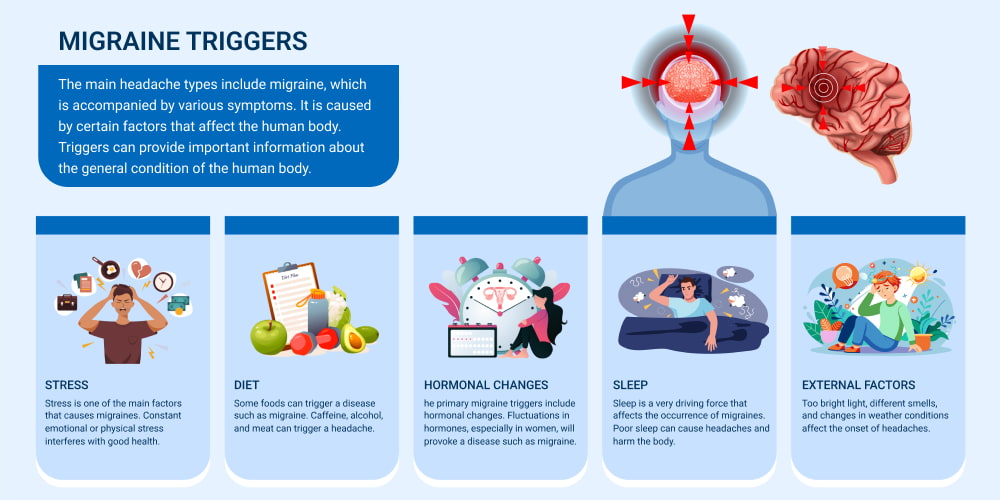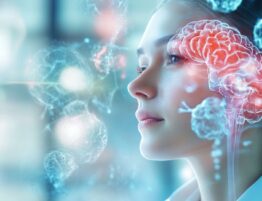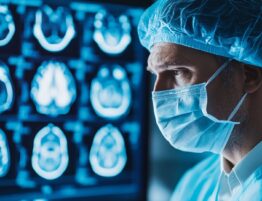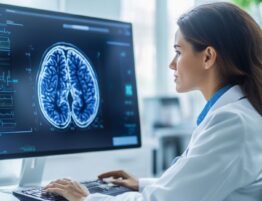Many people experience headaches for a variety of reasons, with symptoms that can differ widely. They cause great discomfort and can have serious consequences. There are different types of pain and different symptoms. Pain can be a result of stress or a serious illness. Understanding different types of headaches is crucial for effective treatment. Migraine, tension, and other types of pain are significant to understand. Identifying patterns in when headaches occur is essential for long-term prevention. Headaches range from mild inconvenience to debilitating medical conditions.
Another serious problem is tension headache, which is associated with stress and muscle tension. It often occurs when a person has neurological diseases and predisposing factors. It’s vital for doctors to become familiar with each patient’s specific condition. Associated symptoms are important clues for an accurate diagnosis. Identifying specific triggers is essential for effective, personalized treatment. Neurological disorders can also be associated with headaches. Therapy and medication are integral and essential parts of facilitating treatment.
Migraine, Tension, or Cluster? Understanding Headache Types
LoneStarNeurology is the best choice for the treatment of neurodegenerative diseases. You can familiarize yourself with the different types of diseases and choose therapy according to your needs. Different types of headaches affect people in unique ways and can indicate various underlying conditions. Pain can vary in duration, intensity, and the way it affects the brain. Understanding the causes and effects of different headache types is crucial for proper treatment. Doctors can then prescribe treatment according to the individual needs of the patient. Here are the main types of pain and their characteristics:
- Migraines. Migraines are often characterized by intense, throbbing pain. It occurs on one side of the head and is accompanied by various symptoms. Migraine triggers involve abnormal brain activity and the release of certain chemicals that cause blood vessels to dilate. People who suffer from migraines are often sensitive to various stimuli. During a migraine, many people experience heightened sensitivity to light and sound, and may have visual disturbances. Migraine is a sign of neurovascular dysfunction and can cause serious problems.
- Tension headache. The pain is the most common type and is characterized by a constant ache around the head and neck. Muscle tension can persist for extended periods, creating a constant, unpleasant sensation. These headaches are associated with stress and depression on an ongoing basis. They can also be associated with muscle tension and indicate serious neurological problems.
- Cluster headache. Cluster headache is one of the most severe and painful types of pain. It occurs on one side of the head and around the eyes. Cluster headaches typically occur in cycles, with periods of frequent headaches lasting weeks or months, followed by headache-free periods. Cluster headaches are often accompanied by tearing, nasal congestion, and redness around the affected eye. Research suggests that abnormal activity in the hypothalamus may trigger cluster headaches.
Migraine Triggers & What They Reveal About Your Health
If you have a neurological disease, you can contact us. Our team will provide you with high-quality services and help you solve the problem. The main headache types include migraine, which is accompanied by various symptoms. It is caused by certain factors that affect the human body. Triggers can provide important information about the general condition of the human body. Hormonal changes, diet, stress, and healthy sleep affect migraines. They can trigger migraines and worsen overall health. Here are common migraine triggers and their effects:
- Stress. Stress is one of the main factors that causes migraines. Constant emotional or physical stress interferes with good health. It leads to poor blood flow and changes in brain function.
- Diet. Some foods can trigger a disease such as migraine. Caffeine, alcohol, and meat can trigger a headache. Foods contain special substances that affect the blood vessels of the brain.
- Hormonal changes. The primary migraine triggers include hormonal changes. Hormonal fluctuations, especially in women, can trigger migraines. Pregnancy and menopause can cause headaches.
- Sleep. Sleep quality plays a crucial role in triggering or preventing migraines. Poor sleep can cause headaches and harm the body.
- External factors. Too bright light, different smells, and changes in weather conditions affect the onset of headaches. Changes in temperature can trigger migraines and make headaches worse.
Migraine triggers are often related to physiological factors and lifestyle elements. Migraine is a common condition, and it can be associated with other neurological problems. People with epilepsy are at risk for migraines. Understanding these triggers is crucial for developing effective treatment plans. Migraines can increase the risk of stroke and affect the overall health of the person’s body.
Tension & Cluster Headaches – More Than Just Pain?
You can choose quality services and get treatment for your neurological condition. Choose the location that is closest to you and take care of your health. Headaches can negatively impact overall health and well-being. Different types of headaches can indicate various systemic issues and cause distinct forms of discomfort. Understanding the specific characteristics of each headache type helps determine the most effective treatment approach. Here are the key characteristics of these headache types:
- Tension headache. Tension headaches are one of the most common types and are frequently associated with chronic stress. The pain typically presents as a dull, constant ache around the head. It can extend to the neck and shoulders, causing widespread discomfort. People who experience persistent stress and anxiety often develop tension headaches. Disruption in normal nervous system function can make people more susceptible to tension headaches. They often feel tension and an increased reaction to pain. People become more sensitive to stimuli such as light and loud sounds.
- Cluster headache. Cluster headaches are often intensely painful and debilitating. The pain is frequently described as unbearable and causes extreme distress. It is associated with hypothalamic dysfunction, which regulates biological rhythms and mood. Cluster headaches may indicate significant neurological issues and typically require prompt medical attention. The intense pain of cluster headaches suggests significant neurological involvement.
Cervicogenic Pain – When Your Neck Causes Headaches
We offer high-quality services and care for each patient. We help support the treatment of neurodegenerative diseases. Someone suffering from chronic pain needs timely intervention and appropriate treatment. Cervicogenic pain is considered a type of secondary headache. It originates from issues in the spine that affect surrounding muscles and nerves. These headaches are often accompanied by neck pain or stiffness. It differs from other types because the source of pain is not from the brain but in the neck area. Here are the leading causes of this pain:
- Poor posture. Constant incorrect posture can cause slouching or hunching. Over time, the cervical spine suffers and is constantly in tension. Misalignment of the cervical spine can cause pain that significantly impacts overall health.
- Trauma. Cervicogenic pain can occur due to neck trauma or damage to the cervical spine. This process can cause pain that is often aggravated during neck or back movements.
- Nerve compression. Herniated discs or degenerative diseases of the intervertebral discs cause pain. Compression of nerves exiting the spinal cord can cause significant pain and neurological symptoms.
Several effective treatment approaches can address cervicogenic headaches. Treatment of this pain focuses on eliminating its underlying cause. Here are the main practical tips for chronic headache management:
- Physical therapy. Strengthening the muscles around the neck will help improve posture. Additionally, improving neck mobility can help reduce headache frequency.
- Medication. Medication prescribed by doctors can help relieve and potentially eliminate pain. Some cases require in-depth intervention to remove nerve blockade.
- Manual therapy. Manual therapy will help relieve pressure on the neck through specific therapeutic manipulations. Massage will reduce headache symptoms.
Chronic Headache Management – Preventing Long-Term Issues.
Effectively managing chronic headaches is essential for overall health and quality of life. Chronic headache management requires a unique approach. Following a structured approach to identifying triggers and treatments can help reduce headache frequency and severity. Here are some interesting tips that will help reduce and avoid pain:
- Lifestyle changes. Lifestyle changes include reducing stress and overcoming it. Yoga and deep breathing exercises will help reduce pain. Maintaining a consistent sleep schedule is an essential component of good health. Physical activity and diet will help maintain health and relieve pain.
- Medication. Chronic headache management includes taking medicines prescribed by therapists. Over-the-counter pain relievers will help relieve moderate headaches. Preventive medications can improve a person’s overall condition and quality of life. For severe headaches, specialized treatments prescribed by a neurologist may be necessary.
- Therapy. Long-term pain management includes cognitive-behavioral treatment. Physical therapy will also help relieve underlying stress and muscle tension. Specialized techniques such as biofeedback and relaxation training can help regulate physiological processes that contribute to headaches.
When Headaches Are a Sign of Serious Neurological Disorders
Different headache types can have alarming symptoms and indicate a bigger problem. Often, the issues are related to brain tumors, aneurysms, or multiple sclerosis. Severe or sudden pain indicates a brain aneurysm. Headaches are often accompanied by nausea, vomiting, or sudden vision loss. Pain that gets worse over time may be associated with multiple sclerosis. Nerve damage causes headaches as part of a neurological problem.
Headaches can be accompanied by a variety of symptoms, such as numbness, weakness, and confusion. Timely chronic headache management is an integral part of a person’s health. Early diagnosis is crucial for the rapid treatment of neurological diseases. Early intervention typically leads to better outcomes and increases the chances of full recovery.













Please, leave your review
Write a comment: